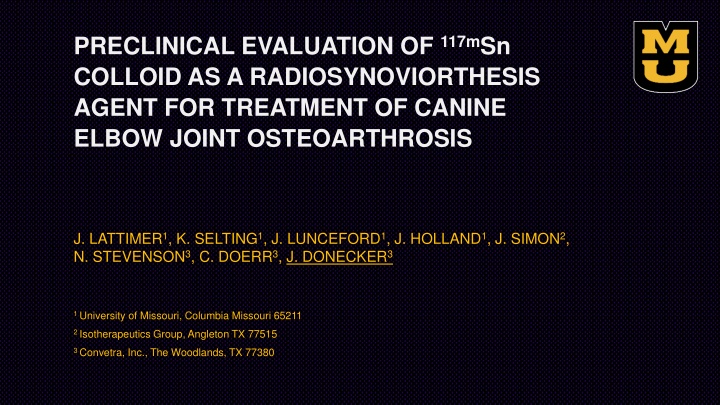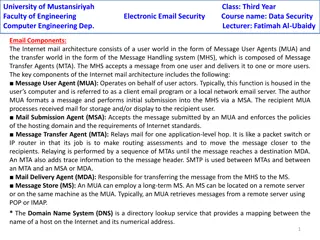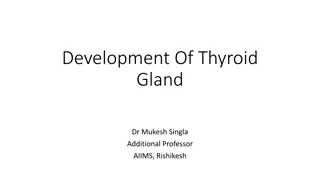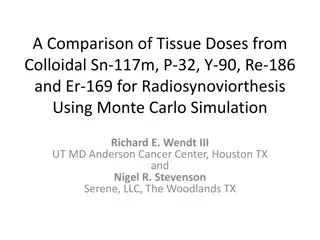Preclinical Evaluation of 117mSn Colloid as a Radiosynoviorthesis Agent for Canine Elbow Joint Osteoarthrosis
Osteoarthrosis/Osteoarthritis is a common disorder resulting from joint injury, trauma, instability, infection, or autoimmune diseases. This study explores the use of 117mSn Colloid for radiotracer treatment in canine elbow joint osteoarthrosis, aiming to reduce inflammation and slow disease progression. The efficacy and safety of this method have been assessed in prior studies involving rats, showing promising results with minimal adverse effects.
Download Presentation

Please find below an Image/Link to download the presentation.
The content on the website is provided AS IS for your information and personal use only. It may not be sold, licensed, or shared on other websites without obtaining consent from the author.If you encounter any issues during the download, it is possible that the publisher has removed the file from their server.
You are allowed to download the files provided on this website for personal or commercial use, subject to the condition that they are used lawfully. All files are the property of their respective owners.
The content on the website is provided AS IS for your information and personal use only. It may not be sold, licensed, or shared on other websites without obtaining consent from the author.
E N D
Presentation Transcript
PRECLINICAL EVALUATION OF 117mSn COLLOID AS A RADIOSYNOVIORTHESIS AGENT FOR TREATMENT OF CANINE ELBOW JOINT OSTEOARTHROSIS J. LATTIMER1, K. SELTING1, J. LUNCEFORD1, J. HOLLAND1, J. SIMON2, N. STEVENSON3, C. DOERR3, J. DONECKER3 1 University of Missouri, Columbia Missouri 65211 2 Isotherapeutics Group, Angleton TX 77515 3 Convetra, Inc., The Woodlands, TX 77380
Disclosure: The work in this project was supported by a contract between Convetra, Inc. and the University of Missouri.
Osteoarthrosis/Osteoarthritis Most common clinical disorder Result of joint injury Trauma Instability Infection bacterial, viral, rickettsial Autoimmune disease
Osteoarthrosis/Osteoarthritis Most common clinical disorder Progression Progression rate Synovial inflammation earliest stage of joint degeneration Ligamentous and capsular injury Cartilage injury Subchondral and perichondral bone injury latest stage of disease
Radiosynoviorthesis Use of a radioisotope preparation to partially ablate the synovium and reduce inflammation in a joint thereby slowing progression of osteoarthritis Challenges Retention of the isotope in the joint tissues Minimal intrinsic chemical toxicity to joint structures Minimal radiation dose to cartilage, bone and ligaments/tendons Minimize radiation dose to rest of patient and others
117mSn Colloid (Synovetin OA ) Half-life 14 days Emissions Conversion electrons 140 keV <300 micron range in tissue Insufficient energy to reach bone and tendons Gamma photons 158 keV imageable on gamma camera Colloid size - ~(3 15 m) Promotes retention in joint through engulfment by joint macrophages Stable in suspension for 5 weeks Easily suspended and injected
Prior studies Prior studies performed in rats Lewis rat meniscal tear model > 150 rats A range of doses were treated Duration of trial was 42 days Confirmed decrease in inflammation Minimal adverse effects on synovium except high dose group No cartilage, bone or ligamentous injury > 99% of isotope retained in the joint
Study design Five young adult purpose-bred female hounds Minimum 5 days acclimation CBC, serum chemistries, urinalysis Radiographs, PET/MRI, post injection nuc. med. scan Joint fluid cytology and analysis Injection of left elbow with 117mSn colloid 2.5 millicuries normalized to 22.75 kg BW by BSA Daily observation for lameness
Study Design Continued 24 hours after injection NM scan of elbow and abdomen Collection of blood, urine and feces for 5 days Standard size samples counted in swipe counter Total excreted urine and feces activity calculated 42 days after injection - all clinical pathology and imaging studies repeated 43 days after injection euthanasia & postmortem All major organs collected and counted for total activity Histopathology of all major organs Histopathology and autoradiography of joint tissues
Results No dog exhibited any lameness after injection NM confirmed retention in joint at 24 hours Urine and feces collection indicated > 99% average retention Imaging studies were normal and static between studies Post mortem studies Organ and elbow activity indicated > 99% retention in elbow No histologic abnormalities were found in organs or joints Micro autoradiography confirmed synovial localization
Conclusions 117mSn colloid (Synovetin) should be evaluated as a radiosynoviorthesis agent in dogs It was retained in the elbow joints with > 99% localization The agent was well tolerated by the animals No adverse reactions to the injection were detected Further trials in dogs with naturally occurring clinical arthritis are needed to evaluate the efficacy of this agent
Future Studies 117mSn colloid (Synovetin trial for treatment of clinical lameness in dogs with grade 1 or 2 elbow arthritis. ) is currently being evaluated in a multicenter Trials are currently being planned for evaluation of this agent in the treatment of osteoarthritis in a limited equine study. Evaluation of efficacy in other joints and more advanced osteoarthritic conditions in dogs
References: The role of synovitis in pathophysiology and clinical symptoms of osteoarthritis, Sellam, J. & Berenbaum, F. Nat. Rev. Rheumatol. 6, 625 635 (2010) New insights on cell death from radiation exposure, Kevin M Prise, Giuseppe Schettino, Melvyn Folkard, Kathryn D Held, Lancet Oncol 2005; 6: 520 28 Role of inflammation in the pathogenesis of osteoarthritis: latest findings and interpretations, Sololove J, Lepus C; Ther Adv Musculoskel Dis, 2013 5(2) 77-94 Direct in vivo evidence of activated macrophages in human osteoarthritis, V.B. Kraus*, G. McDaniel, J.L. Huebner, T.V. Stabler, C.F. Pieper, S.W. Shipes,N.A. Petry, P.S. Low, J. Shen, T.A. McNearney, P. Mitchell, in press, Osteoarthritis and Cartilage (2016)























